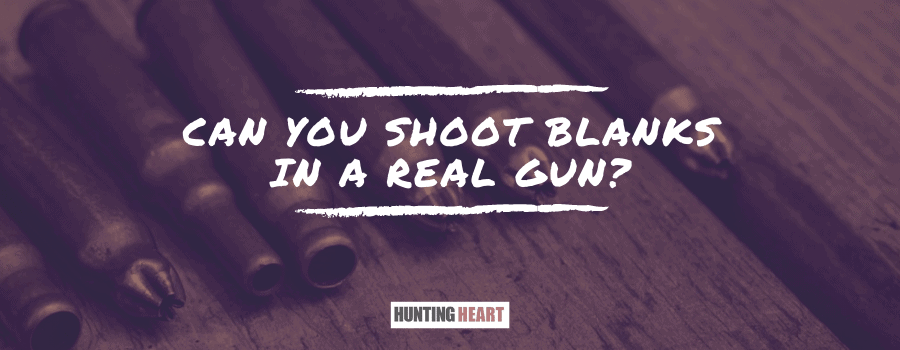

Shooting blanks in a real gun is possible, but it comes with its own set of downsides. If you are a gun enthusiast then you must have probably heard someone use the phrase -shooting blanks- in their statements. It is a common phrase that needs clarification. So what does it mean to shoot blanks?
Shooting blanks is not a harmless activity. There are so many injuries associated with firing blanks in a real gun. In this article, we will understand why people who get shot with blank ammunition still die. As we also tackle what blanks are, why they are used and why they are considered lethal.
To understand what blanks are, you must understand how a bullet works and how it is constructed. For a bullet to be effective, the bullet and gun have to make a spark to set the entire firing process in motion. Therefore, a fuel source that ignites quickly will create a lot of gas to shove the projectile out. The flying projectile is what hits the target. The earliest version of bullets would come in packages that would contain all of those things rattling around but separately.
At the back, the primer also called the percussion cap is the fuse of the firework. It is a small fire that starts a bigger one. The next section of the cartridge is the propellant which is a chemical explosive and acts as the bullet’s main engine. The function of the propellant is to power the bullet down the gun and through the air to the target.
At the front is the bullet which is a tapering metal cylinder that hits the target at high velocities. As it tapers it reduces air resistance so that it goes further and faster and further. The high speed also helps it to penetrate metal, flesh, or whatever target it hits. For the bullet to do damage, it must always penetrate the target.
There are only the Brass .22 Short, 8mm, or 9mm blanks. The construction is of an alloy unsuitable for use in a firearm. You should never attempt to convert a blank-firing gun to take ammunition other than two listed above. In most cases, the pistol may explode and subject them to great harm.
The bullet does damage because it is constructed of a heavy and dense substance. The heavy object keeps its momentum as it flies through the air, and can tunnel into human flesh. If you replace the metal bullet with a piece of cotton or a wadded up paper as is typical of blanks, it will do as much damage as a wadded up piece of paper can ever do. It means the farther the paper flies, the more it matches its mass against the pressure of the air as it tries to push through. It eventually gets slower, and will not do any damage to flesh.
If you are a couple of feet out from a blank then you should have nothing to fear. The only time things get tragic is when people put the guns up to their bodies and fire.
Blank bullets are used for show, and sometimes there is a need to make the show impressive. When blanks are loaded with more gunpowder the more the explosive sound it will make. The edges of the casing are bent inwards to hold the paper more securely and let more pressure to build-up as the gas pushes from behind.
The massive amount of gas will come shooting out of the gun as it expands fast in all directions. However this explosion is harmless but if you press directly to a human skull, the gas, and what is propelled hits fast and the pressure can shatter bone.
As such never point your blank gun at another person. Even though they do not shoot a projectile, someone might mistake it for the real thing.
Blank guns sound and look real therefore you should not expose it in public. Always make sure that you do not leave it where it is accessible to unsupervised children. If a police officer sees one they will probably shoot first and ask questions later.
An 8mm round is loud and can damage hearing. Always fire a blank pistol with arms fully extended and at a safe distance from other people. Remember to keep the muzzle pointed in a safe direction, and never point any blank-firing pistol at anyone.
When you fire a blank gun, the gunpowder gas vents forward and sideways through the front of the barrel, and NOT from the muzzle. Because the gas is hot and may contain particles of powder debris it may burn anyone in proximity. But if you are at an arm’s length it dissipates harmlessly into the air.
You should always clean your and oil your gun regularly as a way to maintain it and avoid unnecessary harm every time you are done shooting it for the day. Blank ammo is corrosive and dirty and if you allow it to build-up on your gun, it may lead to rust and eventually eat away at the finish and metal of your gun. With proper cleaning, you can stop or slow down the process. Every time you sense that your blank gun is not cycling properly, 99.9% of the time the gun needs to be cleaned and oiled.
If you fire your gun and it jams or does not load the next round, there is a high chance that some attention and cleaning will make it function well.
Maintaining your blank firing guns is not a complicated task to do. You can do it if you know the proper method. Below are some of the best tips I recommend that you follow to maintain and clean your blank guns.
Ensure that the area you prefer to clean your gun has proper ventilation. Most of the cleaning agents used to clean a gun are toxic and may sometimes cause noxious. But if you can find non-toxic agents you should consider them first as there are many in the market.
You need a cleaning kit for cleaning your blank gun. The kit includes a brush, the oil for blank firing guns, and a cleaning rod too.
You should always have eye protection while cleaning your gun. The eyewear to use is the same one you will use when cleaning or firing a real firearm.
Always point your gun in a safe direction while cleaning it or any time you are taking it apart. Ensure that it does not point towards you or anyone else.
Always check that your gun is not loaded before starting the cleaning process. For all semi-automatic and full-automatic blank firing guns check that the chamber is empty. And in the case of revolvers ensure there are no blanks and cartridges left in the blank gun.
When stripping your gun you should know that different guns strip differently. Therefore follow the method that is advised for each specific blank gun you are using. Refer to the users’ manuals to check how many pieces your gun will break down.
Once you strip down, attach the brush with the cleaning rod and push the solvent back and forth inside the barrel. It is an effective method that can be utilized for all kinds of blank fire guns regardless if they are the front-firing blank guns. It is because all the gas is discharged in the front barrel making it easy to clean this way.
After cleaning the barrel, you should use the patch cleaner to wipe up the excess solvent and any left residue as well. The process is only complete when there is no leftover residue on the patch.
Lubricating the barrel is a vital maintenance process that you must do using a clean patch. Take a small amount of oil as required and lubricate the barrel so that it will be protected from all kinds of debris.
You can finish the process by putting a small amount of gun oil on a clean cloth and wipe down the outer part of your blank firing gun. Assemble it back and store it in a safe place ready for the next use.
If you can avoid using a blank gun you should. Unless it is for props, ensure that you understand the blank gun regulations of your area. Some may attract lawsuits when discharged improperly or if their use leads to the harm of another person.
Amazon and the Amazon logo are trademarks of Amazon.com, Inc, or its affiliates.

36 years old, been hunting and fishing my entire life – love the outdoors, family, and all kinds of hunting and fishing! I have spent thousands of hours hunting hogs and training hunting dogs, but I’m always learning new stuff and really happy to be sharing them with you! hit me up with an email in the contact form if you have any questions.